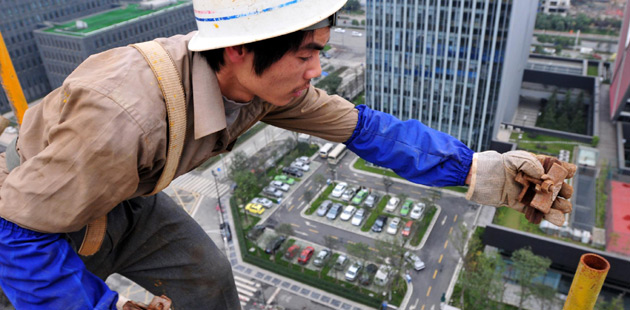Emission reduction efforts in China recognized
Updated: 2011-12-09 09:20
(Xinhua)
|
|||||||||||
BEIJING - Experts have said China has made great efforts in reducing carbon dioxide (CO2) emissions and implementing clean energy, but as a large emitter and a fast growing economy, the country still faces challenges in climate change mitigation.
Fatih Birol, chief economist with the International Energy Agency (IEA), acknowledged China's planned achievements in green technologies over the next 25 years and urged China to pick up the pace in curbing CO2 emissions in order to avoid matching the European Union in terms of cumulative CO2 emissions by 2035.
He said in an exclusive interview with Xinhua that China will add 180 gigawatts (GW) of wind and solar photovoltaic capacity in the next 25 years under its new policies scenario -- a total close to the rest of the world's combined current capacity.
The new policies scenario was made the central scenario in the IEA's recently released World Energy Outlook 2011, which assumes that strong policies will be implemented by countries such as the United States and China, as well as Eurozone countries to try to meet the lower range of commitments made in the Copenhagen and Cancun agreements.
Labeled one of the world's largest sources of emissions, China began its ambition of industrialization within the past 100 years and only sped it up in the past 30 years, leading to fast CO2 emissions growth.
To simultaneously alleviate poverty and maintain sustainable development, the country has made green and low-carbon development and carbon emission mitigation part of its strategic response to climate change, according to He Jiankun, director of the Low Carbon Energy Laboratory at Tsinghua University.
He said China is trying to improve its energy efficiency to conserve energy and reduce greenhouse gas emissions.
China reduced its greenhouse gas emissions by 1.5 billion tonnes between 2006 and 2010, the greatest reduction of any country during the five-year period, according to the report on China's low-carbon development published by the Social Sciences Academic Press at the end of November.
Meanwhile, a white paper released on November 22 by China's State Council, or China's Cabinet, said China has accomplished its energy conservation goals listed in the 11th Five-Year Plan (2006-2010): the aggregate energy consumption per unit of GDP dropped 19.1 percent from that of 2005, which is equivalent to a reduction of 1.46 billion tonnes of CO2 emissions.
According to the paper, which is titled "China's Policies and Actions for Addressing Climate Change," by 2015, the country aims to reduce its CO2 emissions per unit of GDP by 17 percent and energy consumption per unit of GDP by 16 percent compared to the levels in 2010.
China has the world's most ambitious plan to develop clean and renewable energy, and has taken proactive steps toward cutting greenhouse gas emissions, Saleemul Huq, a senior fellow at the London-based International Institute for Environment and Development, told Xinhua after reading the white paper.
He said the country has always played a constructive role in international climate change negotiations. What China has done in addressing climate change should be an inspiration for other countries.
Despite China's efforts in addressing climate change, the nation and other developing countries are receiving little funding and transfers of technology from developed countries, said Hou Yanli, director of the Climate & Energy Program of the World Wide Fund for Nature's Beijing Office.
At the 2010 UN Climate Change Conference in Cancun, Mexico, industrial nations agreed to provide $30 billion in start-up funds between 2010 and 2012, and $100 billion annually by 2020 to help developing countries tackle climate change. But the promise of $30 billion has not yet been kept, partially due to sluggish growth in developed economies, according to Hou, who is attending the ongoing UN Climate Change Conference in Durban.
Under the principle of "common but differentiated responsibilities," which is a cornerstone of the United Nations Framework Convention on Climate Change (UNFCCC), developed countries have pledged to reduce greenhouse gas emissions and provide funding and technology to help developing countries address climate change.
"Industrialized countries have consumed a large amount of resources from developing countries since the Industrial Revolution. They built economic power and left developing countries in poverty," said Yang Fuqiang, a senior advisor on energy, environment and climate change with the Natural Resources Defense Council.
He said it is remarkable that emissions reduction in developing countries accounts for more than 60 percent of the world's total, as they are trying to balance economic development and greenhouse gas emissions reduction.
In comparison, developed countries have easily cut emissions due to the financial crises and economic downturns. The EU set a target of reducing emissions by 20 percent by 2020, and statistics show the EU is half-way toward meeting this goal due to its financial crisis, said Yang, who is attending the UN Climate Change Conference in Durban.
Xie Zhenhua, who led a Chinese delegation to the UN Climate Change Conference in Durban, said on Monday that China is willing to bear the obligations of a legally-binding commitment matched with China's economic development and capabilities based on the principal of common but differentiated responsibilities, fairness and environmental integrity.
Xie, who is also vice chairman of China's National Development and Reform Commission, insisted that all parties obey the Bali Roadmap and other existing legal frameworks to cut greenhouse gas emissions in a multilateral mechanism.
The 17th Conference of Parties to the UNFCCC is taking place in Durban, South Africa, from November 28 to December 9.
Hot Topics
HIV/AIDS, Egypt protest, Thanksgiving, climate change, global economic recovery, home prices, high-speed railways, school bus safety, Libya situation, Weekly photos
Editor's Picks

|

|

|

|

|

|







